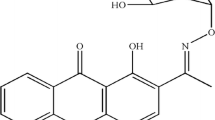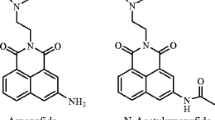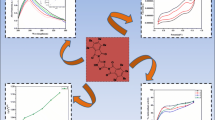Abstract
Anthraquinones consist of several hundreds of derivatives that differ in the nature and positions of substituent groups which are known to have several biological activities including antitumor properties. Interaction of molecules with DNA persists to be an extremely vital parameter while endeavouring to formulate therapeutics. In this study, few anthraquinone derivatives such as 1,2-dihydroxyanthraquinone (alizarin), 1,4-dihydroxyanthraquinone (quinizarin), 1,8-dihydroxyanthraquinone (danthron), 1,2,4-trihydroxyanthraquinone (purpurin), 1,4-diaminoanthraquinone, and 1-methylaminoanthraquinone were analyzed for its possible interaction with calf-thymus DNA through spectroscopy and in silico analysis. Our UV spectroscopic results indicate that all selected anthraquinones interact with DNA probably by external binding. Molar extinction coefficient has been calculated for chosen six anthraquinones. FT-IR results suggest that significant shifts of peaks as well as disappearance of certain characteristic peaks were indicators of the plausible interaction going on due to dye-DNA adduct formation. Among the six dyes used, purpurin showed better results and indicates the relatively strong binding affinity with DNA. Our molecular modeling results also show that purpurin has comparatively higher DNA interaction with a score of −6.18 compared with the ethidium bromide of −5.02 and intercalate the DNA.



Similar content being viewed by others
References
Bi, S., Zhang, H., Qiao, C., Sun, Y., & Liu, C. (2008). Studies of interaction of emodin and DNA in the presence of ethidium bromide by spectroscopic method. Spectrochimica Acta, Part A, 69, 123–129.
Wang, Q., Gao, F., Yuan, X., Li, W., Liu, A., Jiao, K., et al. (2010). Electrochemical studies on the binding of a carcinogenic anthraquinone dye, purpurin (C.I.58 205) with DNA. Dyes and Pigments, 84, 213–217.
Shahabadi, N., & Maghsudi, M. (2013). Gel electrophoresis and DNA interaction studies of the food colorant quinoline yellow. Dyes and Pigments, 96, 377–382.
Siva, R. (2007). Status of natural dyes and dye yielding plants in India. Current Science, 92, 916–925.
Robert, M., Bieganskia, L., & Yarmusha, M. (2011). Novel ligands that target the mitochondrial membrane protein mitoNEET. Journal of Molecular Graphics and Modelling, 2, 965–973.
Zhang, L. Z., & Tang, G. Q. (2004). The binding properties of photosensitizer methylene blue to herring sperm DNA: a spectroscopic study. Journal of Photochemistry and Photobiology, 74, 119–125.
Derksen, G. C. H., Niederländer, H. A. G., & van Beek, T. A. (2002). Analysis of anthraquinones in Rubia tinctorium L. by liquid chromatography coupled with diode-array UV and mass spectrometric detection. Journal of Chromatography. A, 978(1–2), 119–127.
Smith, G. R., Sternberg, M. J., & Bates, P. A. (2005). The relationship between the flexibility of proteins and their conformational states on forming protein–protein complexes with an application to protein–protein docking. Journal of Molecular Biology, 347, 1077–1101.
Saito, S. T., Silva, G., Pungartnik, C., & Brendel, M. (2012). Study of DNA–emodin interaction by FT-IR and UV–vis spectroscopy. Journal of Photochemistry and Photobiology. B, 111, 59–63.
Kanakis, C. D., Tarantilis, P. A., Tajmir-Riahi, H., & Polissiou, M. G. (2007). DNA interaction with saffron’s secondary metabolites safranal, crocetin, and dimethylcrocetin. DNA and Cell Biology, 26, 63–70.
Hackl, E. V., Kornilova, S. V., Kapinos, L. E., Andrushchenko, V. V., Galkin, V. L., Grigoriev, D. N., et al. (1997). Study of Ca + 2, Mn + 2 and Cu + 2 binding to DNA in solution by means of IR spectroscopy. Journal of Molecular Structure, 408, 229–232.
Wang, Q., Wan, X., Yu, Z., Yuan, X., & Jia, K. (2011). Spectroscopic and electrochemical studies on the binding mechanism of DNA with an anthraquinone biological dye, Nuclear Fast Red. International Journal of Electrochemical Science, 6, 5470–5481.
Dipita, B., & Siva, R. (2012). Morindone—an anthraquinone, intercalates DNA sans toxicity: a spectroscopic and molecular modeling perspective. Applied Biochemistry and Biotechnology, 167, 885–896.
Lown, J. W., & Hanstock, C. C. (1985). High filed 1H-NMR analysis of the 1:1 intercalation complex of the antitumor agent mitoxantrone and the DNA duplex [d(CpGpCpG)]. Journal of Biomolecular Structure and Dynamics, 2, 1097–1106.
Zunino, F., Animati, F., & Capranico, C. (1995). DNA minor-groove binding drugs. Current Pharmaceutical Research, 1, 83–94.
Claussen, H., Buning, C., Rarey, M., & Lengauer, T. (2001). FlexE: efficient molecular docking considering protein structure variations. Journal of Molecular Biology, 308, 377–395.
Wainwright, M. (2008). Dyes in the development of drugs and pharmaceuticals. Dyes and Pigments, 76, 582–589.
Hilal, H., & Taylor, J. A. (2007). Determination of the stoichiometry of DNA-dye interaction and application to the study of a bis-cyanine dye-DNA complex. Dyes and Pigments, 75(2), 483–490.
Tan, J. H., Lu, Y., Huang, Z. S., Gu, L. Q., & Wu, J. Y. (2007). Spectroscopic studies of DNA binding modes of cation-substituted anthrapyrazoles derived from emodin. European Journal of Medicinal Chemistry, 42, 1169–1175.
Paul, P., Hossain, M., Yadav, R. C., & Kumar, G. S. (2010). Biophysical studies on the base specificity and energetic of the DNA interaction of photoactive dye thionine: spectroscopic and calorimetric approach. Biophysical Chemistry, 148, 93–103.
Acknowledgments
We wish to express our sincere gratitude for the grant offered by CSIR, New Delhi, India [37(1451)/10/EMR-II]. We wish to thank the VIT University management for the infrastructure provided to carry out the study.
Author information
Authors and Affiliations
Corresponding author
Rights and permissions
About this article
Cite this article
Ghosh, P., Devi, G.P., Priya, R. et al. Spectroscopic and In Silico Evaluation of Interaction of DNA with Six Anthraquinone Derivatives. Appl Biochem Biotechnol 170, 1127–1137 (2013). https://doi.org/10.1007/s12010-013-0259-2
Received:
Accepted:
Published:
Issue Date:
DOI: https://doi.org/10.1007/s12010-013-0259-2




